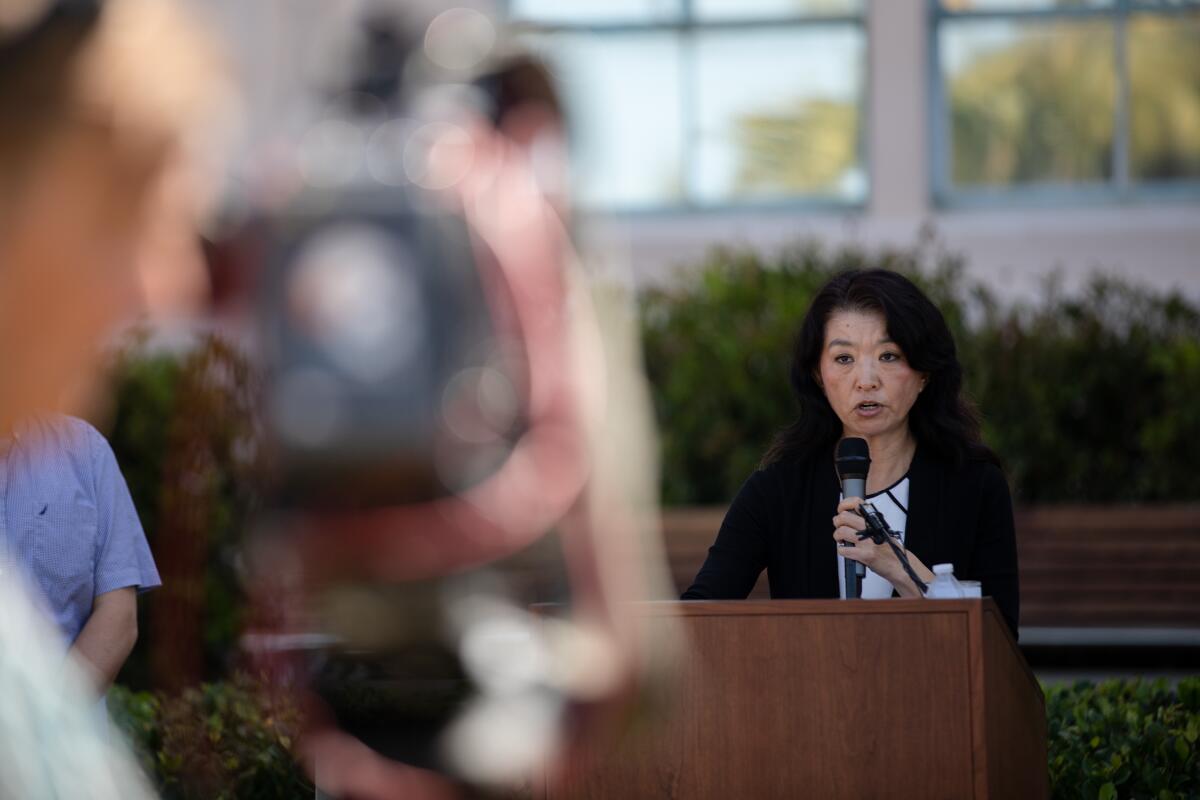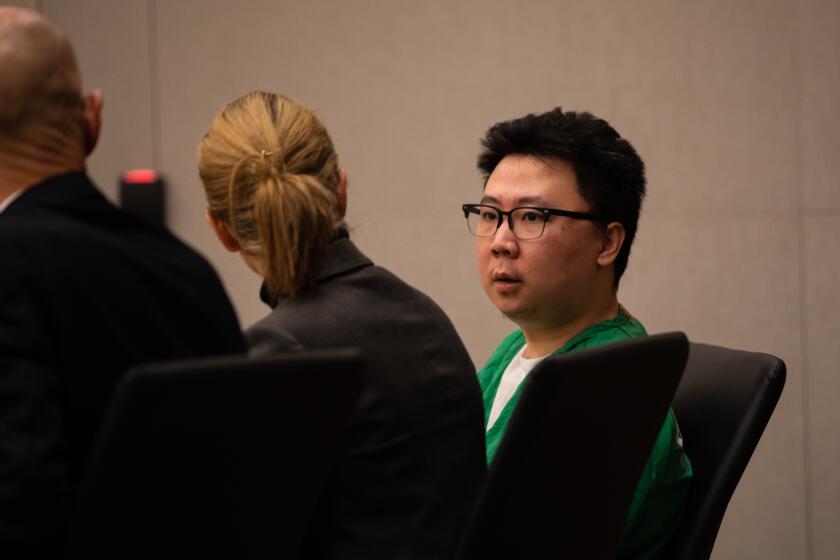‘Even if it’s lawful, it’s awful’: Policing experts critical of shooting that killed Yale-trained scientist

Advocacy organizations are continuing to seek answers in the death of Yan Li
Twelve seconds after Yan Li opened the door to her home, a sheriff’s deputy was threatening to shoot her.
Deputy Jason Bunch had gone to Li’s Little Italy condominium on March 3 to deliver an eviction notice. He had just handed the notice over when he saw the knife she was holding at her side.
“It’s a notice for… put the knife down or I’m going to (expletive) shoot,” he can be heard saying in body-worn camera footage of the incident.
This story is for subscribers
We offer subscribers exclusive access to our best journalism.
Thank you for your support.
These were the moments that ignited an altercation that lasted less than an hour and ended with a San Diego police officer stabbed and Li, a Chinese immigrant and Yale-educated scientist, dead.
More than a month later, many questions remain about the incident. On Thursday, the Alliance of Chinese Americans San Diego held a news conference to demand more information about the shooting, adding to a chorus of individuals who have criticized the incident, including police experts, civil rights lawyers and Li’s friends and family.
“Like many immigrants in the San Diego Asian community, Dr. Li came to the United States to pursue advanced education and the American dream,” Sunny Rickard, president of the organization, said during the news conference. “A few years ago, Dr. Li made the decision to call San Diego home. Sadly, this city prematurely became her final resting place.
“We are heartbroken, not only because a precious life was lost and a brilliant mind is gone, but also because we believe that this tragedy could have been averted,” Rickard said.

Li was fatally shot after she charged officers and deputies who stormed into her home 50 minutes after that first interaction with Bunch. Police said Li stabbed an officer with San Diego’s canine unit in the ensuing struggle, and several deputies and an officer opened fire.
Li died on her doorstep. She was 47.
A local civil rights attorney who watched footage of the incident questioned whether officers and deputies had the right to make entry at all. The San Diego County Sheriff’s Department said after the shooting that deputies learned during the March 3 incident that Li had threatened a maintenance worker and a condominium manager with a knife the day before, and that the incident gave them probable cause to arrest Li.
Julia Yoo, president of the National Police Accountability Project and a longtime civil rights attorney, said officers and deputies would have needed a warrant to make an arrest on those grounds. Neither the Sheriff’s Department nor the San Diego Police Department has said whether a warrant was obtained.
“When the deputy initially went to the door and Dr. Li answered it, she was inside her own home and had a legal right to hold a kitchen knife,” Yoo said. “Dr. Li was threatening no one, including the deputy, herself or anyone else.”
Policing experts who also watched video of the incident questioned the decision by deputies and officers to force their way into Li’s home, and they criticized the tactics law enforcement authorities used to do so.
Several of the experts agreed that fatal force appeared to be warranted, but added that the shooting may never have happened if deputies and officers at the scene had taken things more slowly and requested assistance from a SWAT team that specializes in removing barricaded individuals.
“Even if it’s lawful, it’s awful,” said Sid Heal, a retired Los Angeles County sheriff’s commander who spent nearly half of his 33-year career managing law enforcement special and emergency operations. He added, “This is going to end up being a training film.”
The San Diego Police Department, which is investigating the incident, said no additional information about the shooting would be released until investigators have presented the case to the District Attorney’s Office, which reviews all fatal shootings involving an officer or deputy to determine whether the use of force was legally justified.
San Diego Police Officers Association President Jared Wilson said emergency requests for backup often involve “highly dynamic and challenging scenarios.” He said that in close quarters and confined spaces, noise — whether it be a police dog barking or a supervisor giving commands — becomes a challenge. So does moving around.
“It’s always a tragic situation when someone loses their life,” Wilson said.
A mother, scientist and friend
Li was born and raised in China, friends said. In 1997, a year after Li got married, she followed her now ex-husband to the United States. The couple had a son, who now is 20.
Li received her doctorate from Yale University in 2003 and went on to work as a biostatistician in academic institutions and the pharmaceutical industry, friends and her ex-husband said.
Rui Feng, now an associate professor at the University of Pennsylvania, went to Yale with Li. Feng remembers being impressed by how bright Li was and her ability to explain complex subjects. Li was straightforward and kind, and was always willing to help out her fellow classmates, Feng said.
Feng, a mother, remembers bonding with Li over the challenges of raising children in the world of academia.
After Li was killed and video of the incident was released, several faculty members from Yale wrote an essay in The San Diego Union-Tribune lamenting the loss of the talented scientist. They also questioned why officers and deputies didn’t wait for a mental health clinician to assist in the altercation.
“It is evident from our perspective that Dr. Li, facing eviction, was in a state of crisis when she opened her door to a deputy serving the notice,” the essay read. “Dr. Li expressed doubt as to the authenticity of the law enforcement officer, opened her door holding a knife, and slammed the door after a brief verbal exchange. The officer responded by swearing and shouting, likely validating, in Dr. Li’s perspective, the threat to her welfare.”
Sometime after graduating from Yale, Li moved back to China, Feng and others said. While there, she was diagnosed with a mental health disorder, according to her ex-husband. Investigators haven’t said whether they were aware Li had a condition, but a fellow resident at the complex said he told deputies of Li’s mental health struggles before they entered her home.
James Dean, who had interacted with Li previously, said when he heard deputies were outside one of the complex’s units, he suspected it might involve Li. Dean is the former treasurer of the complex’s homeowners association and knew she was being evicted.
Dean said he went to Li’s unit and tried to talk with the deputies outside her front door. He said he told them Li had a mental health condition and that they needed to call for a Psychiatric Emergency Response Team. PERT teams, made up of a mental health clinician and a police officer, respond to mental health emergencies across San Diego County.
“I said to them, ‘You need to back up,’” Dean said in a recent interview. “‘You really need a psychologist. She’s probably just scared.’”
Deputies told him to leave the area, Dean said.
According to archived radio traffic of the incident, deputies said they were dealing with a barricaded suspect who was armed with a knife. The deputies called for backup. One police officer who responded later could be heard saying: “The sheriff is informing us that the only resources that they are asking for is K-9 and possibly a PERT unit, depending on what they would like to do with this situation.”
A dispatcher reported that PERT units were tied up on calls, and it is not clear whether a PERT unit ever arrived.
Court records indicate that Li bought her condo in 2018, but lost it to foreclosure in 2021 after failing to pay her complex’s homeowner’s association fees. At the time of the foreclosure, Li owed the Acqua Vista Homeowners Association Inc. nearly $32,000, records show.
The homeowners association filed a lien against the home with the county in August 2019. When the lien wasn’t paid, the property was put up for public auction, and because no one bid on it, the home’s title was transferred to the homeowners association.
On Oct. 1, the association officially notified Li of their intention to evict her and any unknown tenants, court records show. A San Diego Superior Court judge approved the eviction in February.
After the shooting, Li’s ex-husband was allowed inside the condo, where he found unopened mail, including correspondence from the homeowners association. He said he believes Li was not aware of the foreclosure.
‘Never should have gotten to that point’
About a week after the shooting, the Sheriff’s Department released a heavily edited 10-minute video that offered a closer look at the tactics that were used during the incident.
Several policing experts who reviewed the video questioned why Bunch, the deputy who first interacted with Li, didn’t simply walk away after successfully delivering the eviction notice.
The Sheriff’s Department executes evictions — a two-step process that begins with a formal posting of an eviction notice on the property. This was the notice Bunch was delivering when he knocked on Li’s door. Had Li refused to vacate the property, sheriff’s deputies would have returned in no less than five days to remove her and change the locks.
David Klinger, a criminology and criminal justice professor at the University of Missouri-St. Louis whose past research topics include police use of force and arrest practices, noted that, from the start, Bunch failed to step back when he saw the knife. Klinger said distance eases any sense of threat and anxiety, allowing for better communication and more control of the situation by law enforcement.
Klinger and others pushed back against the Sheriff’s Department’s statement that Li posed a threat to public safety and noted that Li didn’t appear to threaten Bunch with the knife.
In response to the department’s statement that Li had threatened a condo manager and maintenance worker with a knife a day earlier, experts said a sensible option would have been to write a report and obtain an arrest warrant.
Instead, deputies — some armed with less-lethal firearms, including a beanbag shotgun and a pepper-ball launcher — and San Diego police dog handlers entered Li’s home.
According to footage of the incident, Li, still holding the knife, can be seen in her bedroom as deputies make their way inside. Deputies and officers can be heard shouting over one another, telling Li to show them her hands and to walk out with her hands in the air. Li can be heard yelling “This is invasion,” as a deputy armed with a beanbag shotgun fires at her.
Li charges at the officers and deputies as police canine handlers enter the home. Deputies and officers backpedal out of the condo and two officers and a deputy stumble and fall over each other. Police said Li stabbed one of the canine officers during the struggle, and she could be seen in video footage lunging toward law enforcement when a hail of bullets are fired.
Experts said the video shows there was no clear communication or sense of direction among the deputies and officers. Standard practices call for only one deputy or officer to issue commands to avoid confusion.
“It didn’t appear that there was anybody that was in charge,” Klinger said.
He said it was problematic when the deputy with the beanbag shotgun walked toward Li because he got closer to the knife in her hand and positioned himself in the line of fire between Li and the other deputies and officers. Klinger noted that less-lethal weapons like beanbag shotguns are useful because they allow deputies to maintain their distance from their target.
With multiple deputies and officers huddled near the front door and hallway, they were lucky they weren’t injured by friendly fire when three of them shot Li, Klinger said.
Klinger said he believes the knife attack warranted the deadly force, “but it never should have gotten to that point.”
Several experts said crisis negotiators and members of a SWAT team are better suited to handle situations like the Little Italy incident. They usually work together to get a suspect to surrender. For example, crisis negotiators may try to persuade a suspect over the phone to surrender while SWAT officers get a better sense of the situation by peering underneath the door with a tiny camera.
They key is to not rush the response, Klinger said.
When police force a confrontation, more often than not the outcome is disastrous, said Roger Clark, a use-of-force expert and former Los Angeles County sheriff’s lieutenant.
Ed Obayashi, a use-of-force expert and legal adviser who assists law enforcement agencies across the state with outside investigations into police shootings, cautioned that “the optics (of use-of-force incidents) are always bad.”
“I don’t care what kind of use-of-force it is. They’re all ugly,” he said. “You can’t make a use-of-force video look good.”
In 2020, California lawmakers changed the standard for when officers can use deadly force. Previously, law enforcement officers were allowed to use deadly force when an officer had a “reasonable” fear of imminent harm. Now, officers are only to use deadly force when “necessary” — when their life or the lives of others are in imminent danger and when there is no other alternative to de-escalate the situation such as using nonlethal methods.
The county’s District Attorney’s Office is charged with determining whether an officer or deputy’s fatal use of force was legally justified.
The latest news, as soon as it breaks.
Get our email alerts straight to your inbox.
You may occasionally receive promotional content from the San Diego Union-Tribune.




